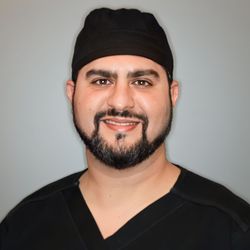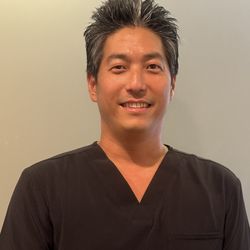When you think about enhancing your smile with cosmetic dentistry in The Woodlands or Conroe, you probably think about things like porcelain veneers, ceramic crowns, dental implants, or maybe even professional teeth whitening. But like a beautiful piece of artwork, you also need the perfect frame to go around it. In this case, that “frame” is your gingival tissue, or “gums.”
Why Would Someone Need Gum Plastic Surgery?
Gingival plastic surgery can be both a therapeutic and cosmetic treatment. The goal is to adjust the shape of the gingival margins (gumlines) against your teeth.
Symmetry is a crucial aspect of beauty. Evenly shaped, symmetrical gumlines appear more natural and don’t detract from the aesthetics of your smile. But when gum margins are uneven, it can significantly impact the way the corresponding tooth looks.
Your gingiva should ideally cover your tooth at the point where the anatomical crown’s enamel starts to taper off and the root of the tooth starts. Sometimes these levels can be too low or too high compared to the neck of your tooth, physically altering the way it looks.
Problems Caused by Gingival Loss/Gum Recession
Although periodontal plastic surgery offers significant aesthetic benefits, it also plays a role in your overall oral health. Since your gums serve as a protective mechanism, it’s crucial that they retain a specific anatomical shape around each tooth root. Unfortunately, with time, habits, age, or disease, the gums can recede and creep down the tooth. Addressing this seemingly cosmetic issue will also help to bypass oral health concerns like:
Tooth Sensitivity — The anatomy of tooth roots makes them much more porous than the whiter, enamel-covered crown. Without the dense outer layer of enamel, all of the nerve endings within those tiny pores become susceptible to stimuli. Whether it’s the touch of a toothbrush, a rush of cold temperatures when you’re breathing in through your mouth, or a zing from your hot cup of coffee, you’ll definitely pick up on the hypersensitivity.
Areas covered by gum tissues don’t see that severe of sensitivity as those that aren’t. But if you lose even 1-2mm of gingiva, your teeth will definitely pick up on it.
Your teeth can gradually become more sensitive as gum recession worsens. Surprisingly, some people don’t suffer from sensitivity no matter how badly receded their gums are. Although you shouldn’t technically use sensitivity to determine the severity of your condition, it’s most certainly a reason to go ahead and seek out care. Especially if over-the-counter treatments like sensitivity toothpaste aren’t helping at all.
Root Caries — Root-surface tooth decay is a big concern for people with receding gumlines. Since root structures are not as dense as enamel (what covers the anatomical crown) they are far more susceptible to bacteria. In turn, cavities can form more quickly and spread at a much more rapid pace.
Covering exposed roots with grafted gingiva provides a safe, natural covering for your teeth. Even though it’s a soft tissue, it still provides much-needed protection to the susceptible root structures underneath.
No matter how well you brush and floss your teeth each day, there will likely be some residual dental plaque left behind. And each time you eat or drink anything, those natural sugars and acids will combine with the plaque residue to further the erosion of tooth structure. Since tooth roots can’t withstand the same “wear and tear” that your tooth enamel does, they’re especially prone to decay.
You may be saying, “I’ve never had a cavity in my life!” Or perhaps you have an extremely high success rate when it comes to keeping tooth decay a thing of the past. But if your roots are exposed due to gum loss, you may not be so lucky.
Spaces Between Teeth — Gum tissues should ideally taper up into a pointed “papilla” between each of your teeth. This gingiva will ideally have a knife-edge that extends further than the other gumline areas.
Unfortunately, things like trauma or periodontal disease can cause your gum tissues to detach and pull back from your teeth. Some of the first symptoms you’ll probably notice are spaces or visible gaps between them as your papilla shrink away. There’s a good chance that you’ll tend to get food caught in those areas after meals. If you’re always having to reach for a toothpick or floss because of something stuck in the same place every time you eat, that might be what’s going on.
Spaces between teeth can also cause what some people refer to as “black triangles”. Although they’re technically not black, this phenomenon is a shadow that’s created between your teeth, caused by soft tissue loss. If you’re smiling in photos, the lighting could cause it to look like black triangles across your smile and between multiple teeth. Black triangle treatment is definitely something we can help to address with gingival plastic surgery.
As you might guess, these open spaces are also more prone to collecting plaque buildup. In turn, they become susceptible to cavity formation.
Are there other options for filling in black triangles and gaps between teeth? It depends on the severity and extent of the spacing. Typically, a cosmetic dentist can close smaller gaps with cosmetic crowns, veneers, or dental bonding. But at a certain point, the gap could be so large that a restoration would look too bulky or fake. Balancing the tooth size with periodontal plastic surgery will provide the best cosmetic results.
Being “Long in the Tooth” — Things like age, lifestyle habits, and tooth misalignment can cause people to become “long in the tooth” as they grow older. Fortunately, it’s not something that gum plastic surgery can’t help to correct.
Gum recession that’s generalized across your teeth can cause them to appear much longer than they ought to. What’s really happening is a loss of structural support around the roots.
Long teeth can detract from your smile’s appearance, even if your teeth are otherwise quite healthy. Our doctors at PCE can implement periodontal plastic surgery or gum grafting to cover the exposed areas, drastically reducing the surface area that’s visible when you’re talking or smiling.
Tooth Mobility and Loss — With the loss of structural support comes issues with integrity. One of the easiest ways to think about it is building a fence. Imagine digging a post hole that’s only 10” deep when it should really be 24” deep. Then apply some pressure as you lean or try to shake the pole. You’ll see it rock, lean, or possibly even come out of the soil altogether. The exact same thing happens when you lose the gingiva and bone that are supposed to be supporting your tooth roots.
Your teeth endure some of the heaviest muscular force in the human body. Biting and chewing bear down more pounds per square inch from your jaw joints than anywhere else. If your teeth can’t stand up to everyday use, minor mobility can evolve into more troublesome issues like tooth loss.
Periodontal Plastic Surgery: What to Expect
Plastic surgery is a staple when it comes to makeovers. Only most people don’t usually think about performing plastic surgery on their mouth (or their gums, at least.) Periodontal plastic surgery is just that. We enhance the way your smile looks by adjusting the soft tissues around your teeth. And like other cosmetic surgeries, this type of procedure often involves adding to or removing from what’s already there.
Our doctors at PCE incorporate a combination of both laser therapy as well as soft tissue grafting. The results are absolutely fantastic. As a periodontal specialist has conducted extensive personal research on soft tissue therapies. His choice method is an Alloderm graft, which is an FDA-approved product that is safe for a variety of health and cosmetic treatments. Allograft treatments provide impeccable results and some of the best soft tissue therapies one of our our doctors at PCE has seen throughout his three-decade long career. The procedure itself can be completed with minimal local anesthetic (numbing medication) with little to no discomfort whatsoever. The recovery time is also quite short.
Enhanced Comfort
Conventional grafting used to require removing soft tissue from the roof of your mouth, then moving it to other areas of tissue loss. Unfortunately, this procedure can be extremely uncomfortable, particularly in the donor site. Healing typically required up to two weeks and a soft diet, along with medication. Thankfully this technique is no longer necessary!
Alloderm soft tissue grafting eliminates the need for invasive surgery or extensive sutures, shortening your recovery. In turn you get to enjoy the results even sooner than you had before. Aside from slightly altering your diet and oral hygiene routine in the first couple of days, you won’t have to change much of our typical daily schedule.
Treatment for “Gummy” Smiles
Inadequate gingival tissues are just one example of where soft tissue therapy is beneficial. Another type of gum treatments that we offer is laser gingival contouring.
Gingival contouring is where we actually reduce the height of the gums, instead of add to it. Lasers are used to safely re-contour the edge of the gumline to shorten bulkier areas of excessive tissue. This treatment can be restricted to 1-2 teeth that appear atypical, or several at a time in the instance of “gummy” smiles. Gummy smiles are a common complaint for individuals who tend to see more gum tissues than teeth.
Let’s consider localized laser recontouring. For instance, perhaps the gums on one side of your smile are a bit “lower” than the other. Looking closely, it appears as if one or two teeth are shorter than the rest. In reality, the gingiva is just covering a larger portion of the tooth anatomy. Even though your tooth looks atypical, it’s completely healthy.
In such a case as this, it’s possible to perform gingival plastic surgery on that area to safely reveal a larger amount of tooth structure. The procedure itself only takes a matter of minutes. And since it’s performed with a laser, there’s practically no recovery time needed. Laser technology significantly reduces swelling and bleeding, making this type of recontouring procedure far superior to more conventional and invasive gummy smile treatments. Most people experience very little discomfort.
Cosmetic Crown Lengthening
“Crown lengthening” is a soft tissue procedure that adjusts the gumlines to reveal a larger surface area of teeth. It can be used for both aesthetic purposes as well as therapeutic reasons (like if you need a crown on a relatively shorter or worn tooth.) Crown lengthening is also used when there are excessive gingival tissues and it’s more challenging to maintain periodontal health.
Although it’s called something different, cosmetic crown lengthening and gum recontouring are essentially one and the same. Clinically we may also refer to the procedure as a “gingivectomy”, being that some of the excessive gingiva is removed.
A gingivectomy isn’t just used for cosmetic treatments, however. It can also serve to help excessively tight or overgrown gum tissues in younger patients or those taking prescription medication. There are several different reasons why you might choose one, so it’s best to work with a gum specialist who can perform the treatment with a soft tissue laser. Again, laser gum therapies speed up healing and drastically reduce the potential for discomfort during the appointment.
Is a Gum Graft the Same as Periodontal Plastic Surgery?
Occasionally you will hear of cosmetic dentists in Houston offering treatments like gum grafts or gum recontouring. If you’re having significant treatment to cover exposed roots or long teeth, your periodontal plastic surgery will involve some type of a gum graft.
Although gum grafting is a certain type of technique used during periodontal plastic surgery, it’s not the only one. Laser therapy is one of the other more common approaches. But since grafting and laser contouring are essentially opposite of one another, you could potentially see how the terms get mixed up when referring to gum plastic surgery in Conroe.
If you’re planning to get plastic surgery on your gum tissues, the best thing to do is to see a specialist. Periodontist The Woodlands will have additional technology and resources on hand to ensure the most streamlined, successful procedure possible. In addition to that he is able to utilize a variety of periodontal plastic surgery techniques to give you the precise results you’re hoping to achieve.
Consider Your Gums During a Smile Makeover
A balance of healthy, symmetrical gum tissues and beautiful teeth can make for an absolutely stunning smile. If you’re considering cosmetic dentistry in North Houston, be sure not to neglect your gums as well. You wouldn’t want to put an expensive piece of art in a make-shift, dollar store frame. It’s crucial to work with a Conroe cosmetic dentist who understands a balance of how teeth and gums blend together.
Cosmetic dentistry extends beyond the shape and color of teeth. It also ties into how your lips, facial profile, and yes – gum tissues – also play a role in overall aesthetics. You want to always be sure that you work with a skilled provider who understands the relationship and role that each anatomical structure plays.
Since gingiva is relatively thin compared to your teeth and the bone underneath, you want to be sure to work with a gum specialist. These extremely delicate tissues must be handled with care, especially when it comes to gum grafting, an Alloderm graft, or other techniques used for treating “long teeth.” Although some dentists may offer limited grafting or recontouring as a cosmetic procedure in their practice, general practices will likely have more limited resources available or only provide 1-2 versions of the plastic surgery. Working with a specialist means you have multiple options available at your fingertips.
Bone and Gum Indentation
Whenever you lose a tooth, the bone in that location begins to resorb or shrink away. This can also lead to the gum tissues pulling back and creating a sunken-in looking surface. One of the ways we combat this process during your oral rehabilitation is to complete bone and soft tissue augmentation.
Bone ridge and gum tissue augmentation helps to build back some of the bulk that was lost due to missing teeth. You might consider ridge augmentation if you’re getting a fixed bridge in that area and don’t want there to be a large gap between the restoration and your gums. Instead, you minimize that space to prevent food or bacteria from accumulating while also improving overall aesthetics.
Uneven Gumlines
Periodontal plastic surgery is the choice treatment for uneven gumlines (gingival margins.) Whether your gums are too high or too low, a periodontal specialist can help you to comfortably adjust the edges of your gingival tissues for ideally sculpted contours.
Unless uneven gumlines are treated, it will cause your teeth to look too short or too long, even though they’re typically sized. In reality the only thing that’s misshaped is your gums (not your tooth.)
Combining gingival augmentation or gum plastic surgery with laser therapy gives you quick results that significantly improve your smile’s appearance. Depending on the type of cosmetic procedure you’re getting, there may be little to no recovery time needed.
Grafting for Exposed Tooth Roots or Long Teeth
Most Houston dentists will mention the need for gum grafting if you have exposed roots or “long teeth.” When gingival augmentation is recommended, they’re usually referring to some of the same types of therapies we provide with our Conroe plastic surgery treatment.
Depending on the method, some gum plastic surgery techniques and soft tissue grafting are one and the same. They enable us to re-cover your exposed tooth with an attached layer of gingival tissue. The results are both functional as well as aesthetic.
If you need a treatment for long teeth in Conroe or The Woodlands, the best thing to do would be to speak with our periodontist. Especially if you want the best cosmetic results. As a gum specialist has extensive training specifically around soft tissue therapies. When you need an aesthetic procedure that involves your gingiva, you need to entrust your smile to an expert.
What is “Allograft”?
Our doctors at PCE method of choice for premier plastic surgeries is with allogenic materials called Allograft. These FDA-approved tissues are used for a variety of medical procedures (not just the mouth.) Essentially, they come from a donor bank from screened, safe sources instead of removing gums from the roof of your mouth.
Allograft tissues such as Alloderm eliminate the need for painful, invasive surgery and thereby significantly improve your healing times.
Is Periodontal Plastic Surgery Really “Plastic Surgery”?
There’s nothing “plastic” about plastic surgery and soft tissue therapies, but the term itself can create some confusion. Essentially, any time you have a physician or expert adjusting your soft tissues, skin, muscles, or mucosal tissues for aesthetic and functional purposes, it’s a form of plastic surgery. So, in that sense, periodontal plastic surgery is in fact a form of plastic surgery.
Since gum plastic surgery involves reshaping your gingiva — be it adding to or taking away from — it’s more of a type of plastic surgery than what people often consider as conventional dentistry. As such, you want to ensure that your practitioner is a member of the American Academy of Periodontology, and that they’re board-certified to perform gum plastic surgery.
A Holistic Cosmetic Approach
Cosmetic dentistry is more than just white, straight teeth. Your entire smile’s overall physical characteristics play a role. Including your gums. When it’s time to think outside of the box and discover ways to dramatically enhance your smile’s beauty, gingival plastic surgery is an excellent choice.
Gingival and periodontal plastic surgery helps create both attractive and healthier gum tissues. And when your smile is healthier, it’s easier to maintain for years to come.
Request a consultation with our periodontal specialist in The Woodlands today to learn more about this unique treatment approach. As one of the Houston area’s most experienced gum specialists had provided advanced soft tissue therapy for over three decades. Here, your smile is in great hands.
Contact our office in The Woodlands or Conroe today to request your appointment.
Office Hours
MON - THU8:00 am - 5:00 pm
FRI8:00 am - 2:00 pm
SAT - SUNClosed
Office Hours
MON - THU8:00 am - 5:00 pm
FRI8:00 am - 2:00 pm
SAT - SUNClosed















